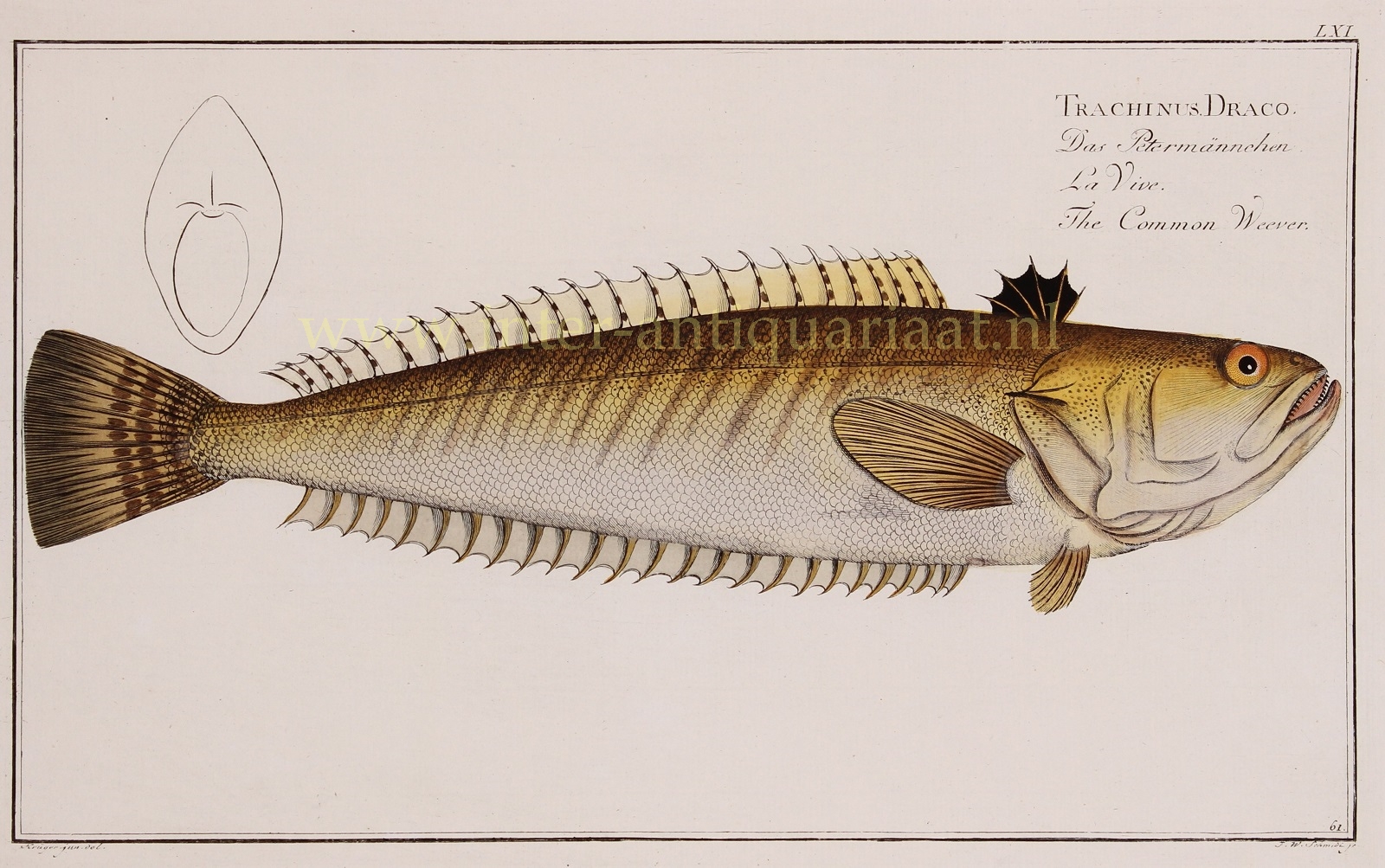Common weever fish – Markus Elieser Bloch, 1782-1795
THE COMMON WEEVER
“Tracinus Drago/Das Petermännchen/La Vive/The Common Weever” (plate 61), copper engraving made by Ludwig Schmidt after the drawing of Krüger jr, for Markus Elieser Bloch’s “Allgemeine Naturgeschichte der Fische” published in Berlin between 1782 and 1795. With original hand colouring. Size: 19 x 38 cm.
According to Bloch in his Allgemeine Naturgeschichte der Fische, a 12-volume, beautifully illustrated comprehensive work on fishes: “The first dorsal fin is black and has five stiff spines, on which one can easily injure oneself. But whether they are poisonous, as Pliny suggests and several ichthyologists confirm, is all the more doubtful, since the proposed antidotes are precisely those that are used in any other injuries caused by a pointed body, namely, getting rid the injured part to prevent inflammation. The English fishermen are in the habit of moistening the wounded part with warm urine and covering it with wet sea sand; the French, on the other hand, use the green leaves of the lovage. Because this fish has an extremely tough life and when it is grasped it is very reluctant, one must be careful not to get stung by the stiff spines, which can still injure even after the fish has died. This has given rise to a law in France, according to which these fish may not be sold with the stingers.
This fish, which does not grow to be more than a foot long, is at home in the Baltic- and North Sea and especially abundant around Holland and East Friesland, also in the Mediterranean Sea and in various parts of the ocean; it usually stays in the depths and comes to shallow places during the spawning season in June. Aristotle therefore rightly associated him with the bank fish. This month as well as the following, it is often caught with nets and fish traps, especially in Holland. The weever has a very tasty meat, which is not difficult to digest and is considered a delicacy by the Dutch. It is cooked after its head and the nearby thorns have been cut off, usually in salted water and eaten with either a sauce Hollandaise or anchovy broth. The weever lives on aquatic insects and the brood of other fish, snails and crabs. When it is young ist enemies are all the rest of the meat-eating water dwellers.”
Bloch’s labour on the “Allgemeine Naturgeschichte der Fische” occupied a considerable portion of his life, and is considered to have laid the foundations of the science of ichthyology. The publication was encouraged by a large subscription, and it passed rapidly through five editions in German and in French. Bloch made little or no alteration in the systematic arrangement of Peter Artedi and Carl Linnaeus, although he was disposed to introduce into the classification some modifications depending on the structure of the gills. To the number of genera before established, he found it necessary to add nineteen new ones, and he described 276 species new to science, many of them inhabitants of the remotest parts of the ocean, and by the brilliancy of their colours, or the singularity of their forms, as much objects of popular admiration as of scientific curiosity.
Bloch is considered the most important ichthyologist of the 18th century.
Price: SOLD


